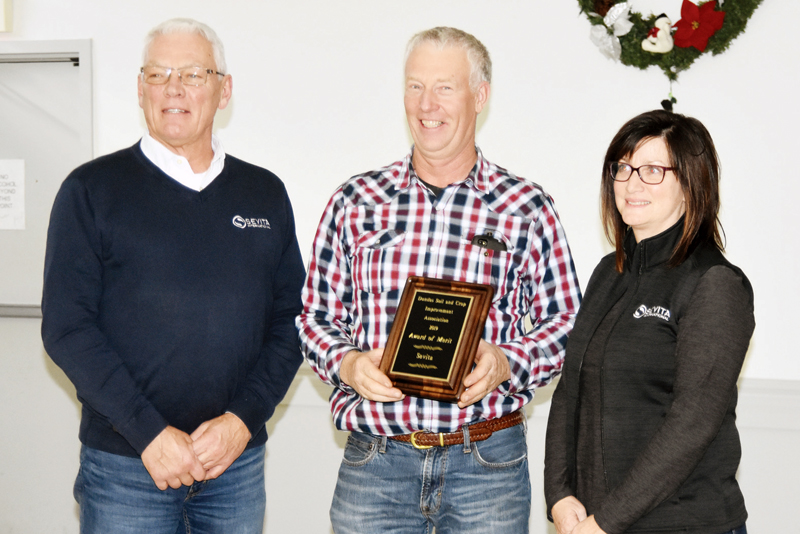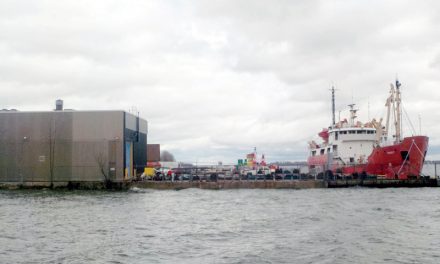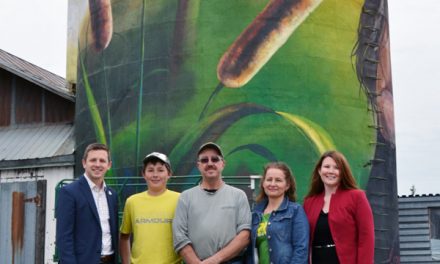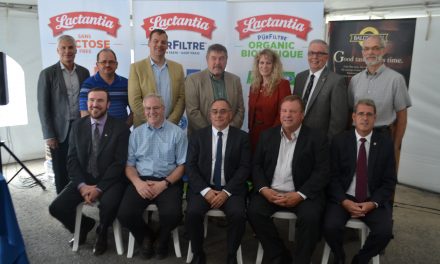Award of Merit
The DSCIA presented its annual awards at the AGM on Thur., Dec. 12, 2019 at the Chesterville Legion. The Award of Merit for 2019 went to Sevita International from Inkerman. Receiving the award were Sevita’s David Guy (left) and Lisa Hall (right), presented by Brian Vandenburg. Moore photo

The DSCIA named Winchester’s John Cinnamon (left) as their choice for Farmer of the Year. Cinnamon runs his own farm, sells seed and does some custom harvesting. The award was presented by Brian Vandenburg.
Moore photo
CHESTERVILLE—The Dundas Soil and Crop Improvement Association (DSCIA) met for its annual general meeting at the the Chesterville Legion on Thurs., Dec. 12, 2019. The day began with an introduction by president, Mike Roosendaal. The speakers for the day included Colleen Acres, Ontario Soil and Crop Improvement Association lead (OSCIA), Sheila James of Workplace Safety and Road Safety, Graham Duke and Ron Toonders (2019 DSCIA bus trip to Newfoundland) and Gilles Quesnel, Independent Agronomist.
Acres began her slide show discussing workshops and eLearning in the subjects of Environmental Farm Plan, Growing Your Farm Profits and Biosecurity. For the Environmental Farm Plan, a formation of the business’s challenge or opportunity was discussed and ways to prepare for such events. Then a plan should be implemented and the farmer should check to see if there is cost sharing funding available through various government programs.
Acres then got into the programs that are available for the upcoming season. The three key priorities are economic development, environmental stewardship and protection and assurance.

The 2019 Dundas County Innovative Farmer Award was presented to Brent Vandenbosch of VandenBosch Elevators by Brian Vandenburg.
Moore photo
Economic development may include a business analysis such as farm financial analysis and business plan, market development including marketing plans, market products in Canada, market products internationally and development of new products or processes and productivity, planning for increased labour productivity, and technology and equipment to improve labour productivity.
Environmental stewardship projects are nutrient management and soil health planning, cover crops, adding organic amendments to soil, fragile land retirement, riparian buffer strips, windbreaks and wind strips and erosion control structures. Other concerns were nutrient recovery from wastewater/washwater, manure storage improvements and runoff control for livestock facilities. Protection and assurance animal health project categories were identified as education, training, assessment and planning, improvements to animal housing and handling, animal handling equipment, new construction, modification or new technologies to improve animal handling, traceability equipment (animal health) and system improvements.
Preventing the spread of diseases topics include: defining zones and control access points, establishing cleaning and disinfection practices, establishing isolation or segregation facilities, preventing access by wildlife, pests and rodents, animal health management and establishing facilities to manage deadstock.
Food safety project categories were: food safety and traceability gap assessment and pre-audit, food safety and traceability training, food safety equipment, traceability equipment and food safety systems improvements. Plant health projects topics were: education, training assessment and planning, plant-pest monitoring and management tools and equipment, installation of continuous rinse systems, preventing introduction and spread of pests through isolation, sanitation and controlling workflow and preventing access by wildlife (pests and rodents).
Next up on the guest speaker list was James and her assistant from Workplace Safety and Road Safety, Jason Kiloran. The pair talked about farmers’ lung. Farmers’ lung is a result of prolonged exposure to dust and mould from the grain bin, hay mow, silo or pretty much any surface that has moisture.
The symptoms are shortness of breath and lethargy. The particles and spores cause fibrosis of the lungs and the patient will have to go on oxygen or have a lung transplant. There is no cure for farmers’ lung. Kiloran demonstrated how to use a filter and respirator for the prevention of farmers’ lung. He showed how to properly fit a respirator and how to change the different filters.
Duke and Toonders followed as speakers talking about DSCIA’s trip to Newfoundland. The group had a great time visiting different farms, plants, hotels and tourist attractions. throughout the province.
Quesnel was the last speaker in the morning session and he talked about the not so great year it had been for the crops in Eastern Ontario. He talked about the late planting in a damp spring and then a dry summer and the affects it had on the corn and soybeans in the area. He showed the precipitation amounts throughout the area, which varied from 324 mm to 474 mm from May until the end of September, well short of the average in 2017 of 684 mm.
Quesnel went on to show the heat units for the growing season which were way down compared with other years. The minimum temperatures for the month of September showed a great number of days with a low of 6 C or less. The agronomist then went on to talk about the invasion of leaf hoppers and the devastating effect it had on alfalfa. He says this could have been up to 50 per cent of the crop but it went basically unnoticed.
He said, “If you lost 50 per cent of your corn harvest, you would be up in arms but when you lose 50 per cent of your alfalfa there was barely a whisper.” Alfalfa was also a victim of the cold winter in early 2019 which caused a lot of winter kill. He then talked about the success of the Compaction Day event hosted in August.
The group took a break for lunch.
After lunch, the DSCIA went through their financial situation and then voted on their new executive for 2020 followed by the awards. The Award of Merit for 2019 went to Sevita International from Inkerman after they were the host of the association’s Compaction Day. Receiving the award were Sevita’s David Guy and Lisa Hall. It was presented by Brian Vandenburg. Vanden Bosch Elevators from Chesterville won the Dundas County Innovative Farmer Award and was accepted by Brent Vanden Bosch. The Farmer of the Year went to John Cinnamon of Winchester.
The final speaker of the day was Alex Barrie from OMAFRA who was the main man at the DSCIA Compaction Day. Barrie went through the reason why compaction is so important, this being, decreased water filtration, reduced water holding capacity, reduced root growth and root depth, increase soil erosion, reduced nutrient uptake, increased input cost, reduced yield and reduced water and soil quality. He reviewed the data that was collected on that day and explained how the tests worked and how to reduce compaction.
He discussed types of tires and inflation fluctuation. He demonstrated with the charts that were collected of the raw material on all tires and tracks that were run through the test in August.













